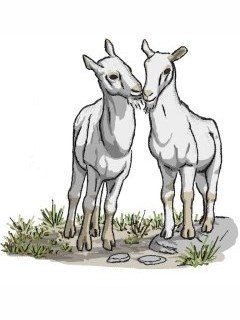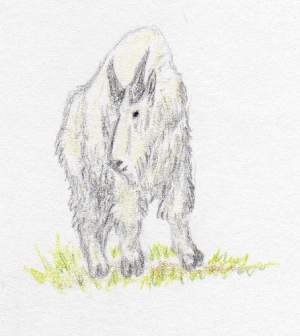Caprids: Goats and Sheep
Capra sp., Ovis sp., and several other genera.
 Caprids are agile and hardy bovids that live in rugged, rocky, precipitous terrain. They often dwell on sheer cliff-sides, and can run up and down rock faces that are inaccessible to most other animals. Females and their young live in herds, males are typically solitary outside of the mating season but may be found in small bachelor herds.
Caprids are agile and hardy bovids that live in rugged, rocky, precipitous terrain. They often dwell on sheer cliff-sides, and can run up and down rock faces that are inaccessible to most other animals. Females and their young live in herds, males are typically solitary outside of the mating season but may be found in small bachelor herds.
Some species of caprids are primarily browsers, selectively eating the tips of shrubs and trees, vines, and leafy forbs. Others are grazers, munching on the carpet of grasses, moss, ferns, and lichen that covers the ground. Still others split the difference, eating whatever is available. Many can thrive on even sparse and coarse vegetation due to their broad diet.
All caprids of both sexes have backward-pointing horns. The horns of the males are usually larger and in many species can be spectacular. They use their horns in vigorous head-to-head ramming contests to establish dominance. Those species with short horns can use them to stab as well as bash.
Goats and Ibex, Capra sp.: Goats are primarily browsers with some grazing. Males have long tufts of hair - beards - on their chins, grow very large horns, and have a rank smell. In most species of goat the horns curl backward. One species of goat Capra hircus has been domesticated. This goat often has reduced size horns, will follow people around in large herds, and will conveniently stay in pened enclosures. Wild goats are native to Europe, Asia, and the Arabian peninsula. Domestic goats are found wherever there are people, and have established feral colonies on all continents except Antarctica and a great many islands. Domestic goats often cause ecological havoc when they go feral on islands or when their herds overbrowse marginal land.
Markhor, Capra falconeri: Markhor are wild goats of the Himmalayas. The males have spectacular horns that spiral backward from their heads. They fight by locking horns and wrestling.
Sheep, Ovis sp.: Sheep are primarily grazers. The males grow large coiled horns. Domestic sheep Ovis aries, urial sheep Ovis orientalis, and argali sheep Ovis ammon prefer gently rolling hills rather than cliff-sides. Other sheep - bighorns Ovis canadensis, Dall's sheep Ovis dalli, and mouflons Ovis musimon frequent cliff faces, boulder jumbles, and crumbling scarp like other caprids. Domestic sheep have thick wool, which is used to make garments. Some domestic sheep are hornless, while other varieties can have four or six horns at once. Wild sheep live in Asia, Europe, and western North America, domestic sheep can be found worldwide in association with humans.
Tahr, Hemitragus jemlahicus: The Himalayan tahr is a common resident of the Himalaya mountains, and has been introduced to New Zeeland, South Africa's Table Mountain, and parts of North America. Tahr are mainly grazers. They have long body hair and short curved horns.
Barbary Sheep, Ammotragus lervia: Barbary sheep are native to North Africa. They thrive in hot arid lands, and have colonized the American Southwest and Iberia. They are sand-colored, and have medium-sized, backward curving horns. Both sexes have a "mane" of long fur along the underside of their neck, but this is longer in males. They graze and browse, and are able to obtain all their water needs from vegetation if necessary ( they do, however, enjoy drinking and bathing). They travel large distances to find food in their dry environment.
Bharal, Pseudois nayaur: Bharal, or blue sheep, are grazers that live on plateaus and open slopes at high elevations. Due to the lack of cover in their native habitat, they rely on their protecive coloration to avoid danger, and remain motionless when approached. Once they know they have been discovered, however, they run up cliffs to escape. Bharal are found in the Himalayas and Mongolia. They have large horns that curve back and sideways.
Serow, Capricornus sp.: Serows are caprids with short, slightly curved horns. Those from colder climates will grow bushy coats of hair. They are browsers, and will mark their teritory with a vinegar-smelling musk. Serows are found in east Asia and many offshore Asian islands, including Japan, Taiwan, and Sumatra.
Goral, Nemorhaedus sp.: Gorals are similar to serows (see above) in appearance and behavior, but are smaller and inhabit even more inaccessible terrain. They are found in Siberia and east Asia.
 Mountain Goat, Oreamnos americanus: Mountain goats are robust caprids with short, backward pointing horns and a dense coat of white wool. Mountain goats are primarily grazers. They are bad tempered and will often stand their ground and fight if threatened.
Mountain Goat, Oreamnos americanus: Mountain goats are robust caprids with short, backward pointing horns and a dense coat of white wool. Mountain goats are primarily grazers. They are bad tempered and will often stand their ground and fight if threatened.
Chamois, Rupicapra rupicapra: Chamois are coarse-furred caprids with short horns that jut forward from the forehead and then hook back at the ends. They are primarily grazers but will supplement by browsing pine needles, bark, and shoots in winter. Chamois are native to central and southern Europe, Turkey, and the Causcasus mountains, and have been introduced to New Zeeland. They are valued for their smooth and absorbent leather.
Takin, Budorcas taxicolor: The takin is a large, sturdy caprid with a golden-colored coat of fleece. They have short horns that coil to the side and back and an arched nose. Takin live in high montainous areas of southeast Asia, in herds of about 20 closely related individuals. In summer, many family herds may join to form groups of up to 300 on the high slopes. They rut in summer, a single calf is born in spring. Takin are both grazers and browsers. Access to salt is important, and they often linger near salt deposits. If disturbed, takin will cough in alarm, and then retreat to thick vegetation and lie down for concealment. They are hunted for their meat, said to be delicious, and their golden pelts.
Musk Ox, Ovibos moschatus: Musk ox are large, sturdy caprids with short legs. Their fur is long and shaggy, their horns form a thick shield over their crowns and then hook forward. They are found in the northern reaches of North America, where they are exclusively tundra dwellers. In summer, they frequent wet areas such as bogs, lake shores, or river valleys where they graze grass, moss, and lichen. In winter, they move to higher elevation and browse willows and brush. Musk oxen live in herds of around 20 individuals. They can be rather cranky, jostling and ramming to establish dominance. In the rut, during summer, musk oxen bulls bellow and bash heads to compete for harems of about 6 cows. When threatened, musk oxen will form a ring or semicircle around their calves with the adults facing the threat, ready to defend their calves with their horns against any predator that gets too close.
Back to Bovids
 Caprids are agile and hardy bovids that live in rugged, rocky, precipitous terrain. They often dwell on sheer cliff-sides, and can run up and down rock faces that are inaccessible to most other animals. Females and their young live in herds, males are typically solitary outside of the mating season but may be found in small bachelor herds.
Caprids are agile and hardy bovids that live in rugged, rocky, precipitous terrain. They often dwell on sheer cliff-sides, and can run up and down rock faces that are inaccessible to most other animals. Females and their young live in herds, males are typically solitary outside of the mating season but may be found in small bachelor herds.
 Mountain Goat, Oreamnos americanus: Mountain goats are robust caprids with short, backward pointing horns and a dense coat of white wool. Mountain goats are primarily grazers. They are bad tempered and will often stand their ground and fight if threatened.
Mountain Goat, Oreamnos americanus: Mountain goats are robust caprids with short, backward pointing horns and a dense coat of white wool. Mountain goats are primarily grazers. They are bad tempered and will often stand their ground and fight if threatened.